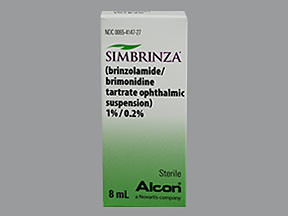BRINZOLAMIDE/BRIMONIDINE SUSPENSION - OPHTHALMIC
PHONETIC PRONUNCIATION: (brin-ZOE-la-mide/bri-MON-i-deen)
COMMON BRAND NAME(S): Simbrinza
GENERIC NAME(S): brinzolamide/brimonidine tartrate
Uses
USES: This product contains two medications used to treat high pressure in the eye due to glaucoma (open-angle glaucoma-type) or a certain other eye disease (ocular hypertension). Lowering high pressure in the eye reduces the risk of vision loss, nerve damage, or blindness. This product contains brinzolamide and brimonidine. These two medications work together to decrease the amount of fluid within the eye. Brinzolamide belongs to a class of drugs known as carbonic anhydrase inhibitors. Brimonidine belongs to a class of drugs known as alpha agonists. This product is not recommended for use in children younger than 2 years of age due to an increased risk of serious side effects such as very slowed breathing. Ask the doctor or pharmacist for details.
How to use BRINZOLAMIDE/BRIMONIDINE SUSPENSION - OPHTHALMIC
HOW TO USE: This medication is for use in the eye(s) as directed by your doctor, usually one drop in the affected eye(s) 3 times daily. Shake the bottle well before each dose. To apply eye drops, wash hands first. To avoid contamination, do not touch the dropper tip or let it touch your eye or any other surface. The preservative in this product may be absorbed by contact lenses. If you are wearing contact lenses, remove them before using eye drops. Wait at least 15 minutes before replacing your contact lenses. Tilt your head back, look upward, and pull down the lower eyelid to make a pouch. Hold the dropper directly over your eye and place one drop into the pouch. Look downward, gently close your eyes, and place one finger at the corner of your eye (near the nose). Apply gentle pressure for 1 to 2 minutes before opening your eyes. This will prevent the medication from draining out. Try not to blink or rub your eye. If directed to use this medication in both eyes, repeat these steps for your other eye. Wait several minutes for your vision to clear before driving or operating machinery. Do not rinse the dropper. Replace the dropper cap after each use. If you are using another kind of eye medication (such as drops or ointments), wait at least 5 minutes before applying other medications. Use eye drops before eye ointments to allow the drops to enter the eye. Use this medication regularly to get the most benefit from it. To help you remember, use it at the same time(s) each day. It is important to continue using this medication even if you feel well. Most people with glaucoma or high pressure in the eye do not feel sick.
Side Effects
Precautions
Interactions
Overdose
Images
Reviews
Faq for BRINZOLAMIDE/BRIMONIDINE SUSPENSION - OPHTHALMIC
Brinzolamide/Brimonidine suspension is an ophthalmic medication used to lower elevated intraocular pressure (IOP) in patients with open-angle glaucoma or ocular hypertension.
The combination of Brinzolamide and Brimonidine in suspension form works by reducing the production of aqueous humor (fluid) in the eye and increasing its outflow to lower IOP.
Common side effects may include blurred vision, dry eyes, eye discomfort, foreign body sensation, conjunctival hyperemia (redness), or allergic reactions such as itching and hives.
You should typically use one drop of the suspension in the affected eye(s) three times per day, with approximately 8-hour intervals. Follow the instructions provided by your doctor or on the prescription label.
Brinzolamide/Brimonidine suspension is not recommended for children below the age of 2 years. Safety and effectiveness in pediatric patients have not been established.
You should avoid touching the dropper tip to any surface, including your eyes or hands, to prevent contamination. Contact lenses should be removed before administering the suspension and can be reinserted 15 minutes after instillation.
Brinzolamide/Brimonidine suspension may interact with certain drugs, including other eye medications and oral carbonic anhydrase inhibitors. Inform your doctor about all the medications you are taking to avoid potential drug interactions.
If you miss a dose, apply it as soon as you remember. However, if it is almost time for the next scheduled dose, skip the missed one and continue with your regular dosing schedule. Do not apply a double dose to make up for the missed one.
The use of Brinzolamide/Brimonidine suspension during pregnancy or breastfeeding is generally not recommended. Consult your doctor for a proper assessment of the potential benefits and risks before using the medication.
Disclaimer
IMPORTANT: HOW TO USE THIS INFORMATION: This is a summary and does NOT have all possible information about this product. This information does not assure that this product is safe, effective, or appropriate for you. This information is not individual medical advice and does not substitute for the advice of your health care professional. Always ask your health care professional for complete information about this product and your specific health needs.

No Reviews Yet